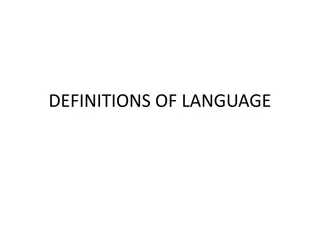Virginia Woolf and Symbols in "To the Lighthouse
Symbols and motifs play a crucial role in Virginia Woolf's novel "To the Lighthouse," with the lighthouse itself being a central and powerful symbol. Woolf's emphasis on symbols that suggest and evoke rather than explicitly inform adds depth to the narrative, allowing for reader interpretation and engagement. Through the use of symbols like the lighthouse and painting, Woolf explores themes of consciousness, relationships, and the passage of time.
Download Presentation

Please find below an Image/Link to download the presentation.
The content on the website is provided AS IS for your information and personal use only. It may not be sold, licensed, or shared on other websites without obtaining consent from the author. Download presentation by click this link. If you encounter any issues during the download, it is possible that the publisher has removed the file from their server.
E N D
Presentation Transcript
DAMIETTA FACULTY OF EDUCATION DAMIETTA FACULTY OF EDUCATION DEPARTMENT OF ENGLISH DEPARTMENT OF ENGLISH THIRD YEAR/ THIRD YEAR/ SPECIAL EDU. SPECIAL EDU. NOVEL NOVEL 4 4TH LECTURE- - MARCH DR. DR. ENGY SALAH ENGY SALAH TH. . LECTURE MARCH 2020 2020
CONTENTS: Virginia Woolf and Symbols To the Lighthouse: Symbols
VIRGINIA WOOLF AND SYMBOLS Symbols and motifs are very important in the writings of Virginia Woolf. She knew how an image could grow to symbolic potential in order to carry her narrative forward; and she was sensitive to the way poetic connotations accrue to define the numerous inflections upon which the meaning of her novel would rest. Virginia Woolf seems to have dedicated a large amount of her time and thought determining the nature and scope of symbols. In her diary as well as in her critical essays, she worked out a theory about the use of symbols. One important aspect which she stresses in one of her essays, entitled On Not Knowing Greek , is that a symbol should have some similarity to the thing symbolized, which it should make splendid . There must be some community between the thing symbolized and its meaning because, otherwise, it would not be a symbol but only empty imagination. By saying that symbols should not inform but suggest and evoke ,Virginia Woolf stresses the importance of not completely working out a symbol s meaning but leaving a part of it to the reader s imagination.
THE LIGHTHOUSE The lighthouse is the central image as well as the strongest and most meaningful symbol of the novel. Firstly, this is indicated by being part of the title, immediately making it a focus of attention, and, secondly, by headlining Part 3 of the novel. It is also a recurring motif throughout the novel. Its reality in Virginia Woolf s childhood years at St. Ives was the Godrevy light. The lighthouse functions in two ways: as something to be reached, and as the source of a flashing light.[16]But not only the physical presence of the lighthouse becomes important. It also exists within the consciousness of individual characters. The symbolic meanings of the lighthouse differ, change and are even contrasted in different contexts and with regard to different characters in the novel. Due to these multiple and varying meanings, the lighthouse carries the narrative forward.
PAINTING: Painting represents understanding and catharsis. Lily Briscoe paints a scene that includes Mrs. Ramsay reading to James in the drawing room. She ponders Mrs. Ramsay's character, who is "like a bird for speed, an arrow for directness," a "commanding" presence opening windows and shutting doors. Not attempting a "likeness" but rather another sense of "mother and child," she depicts Mrs. Ramsay as a purple triangular shadow. Later Mrs. Ramsay in "The Window," Chapter 11, describes herself as a "wedge of darkness," which resembles a purple triangular shadow. Lily navigates the issue of balance in the painting. Working on the composition, she achieves a certain understanding by moving the tree (symbolizing love, life, and connection, which for Lily show themselves in Mrs. Ramsay) to a more prominent position to reflect the Mrs. Ramsay's essence and importance. The act of painting represents catharsis for Lily. At the beginning of the novel, she is anxious about showing the painting to others. Introverted and sensitive, she is unsure about her abilities and intimidated by Charles Tansley's derogatory comments about women's inabilities as artists. Although she continues painting, Lily cannot achieve complete catharsis for her, the inaccessible until she fully understands her feelings about Mrs. Ramsay. When Lily finally allows herself sufficient distance, she is able to finish the new painting with a simple line down the center, achieving the complete sense of balance she has sought, and she can accept herself as an artist. If she achieves understanding in "The Window," she achieves catharsis in "The Lighthouse," as she finishes the painting at the same time as Mrs. Ramsay's husband and children reach the lighthouse.
TREE: While the pear tree receives the most attention in the novel, it is noteworthy that the summer house is surrounded by trees. Representing love, life, and connection, trees protect the home and those in it, as does Mrs. Ramsay. In "The Window," Chapter 4, Lily Briscoe and William Bankes pause by the pear tree, discussing Mr. Ramsay's stalled career, a discussion showing the intimacy of their deep friendship. At that spot Lily imagines a kitchen table which, because of Andrew Ramsay's explanation of Mr. Ramsay's field, represents the patriarch and his work "lodged" in the tree. Lily's image, considering her love for the Ramsays, illustrates how Mr. Ramsay's difficult professional life and demanding presence harm the family's well-being. When Lily changes the composition of her painting by moving the tree closer to the center, she affirms the tree's importance as a representation of the inner spirit of Mrs. Ramsay, which Lily is trying to capture: the love, life, and connection that make her a nurturing, protecting, and stabilizing force in others' lives.
IMPORTANT QUOTATIONS: 1 Who shall blame him? Who will not secretly rejoice when the hero puts his armour off, and halts by the window and gazes at his wife and son, who, very distant at first, gradually come closer and closer, till lips and book and head are clearly before him, though still lovely and unfamiliar from the intensity of his isolation and the waste of ages and the perishing of the stars, and finally putting his pipe in his pocket and bending his magnificent head before her who will blame him if he does homage to the beauty of the world? As Mr. Ramsay strolls across the lawn in Chapter VI of The Window, he catches sight of Mrs. Ramsay and James in the window. His reaction comes as something of a surprise given the troubled ruminations of his mind described just pages before. He, like nearly every character in the novel, is keenly aware of the inevitability of death and the likelihood of its casting his existence into absolute oblivion. Mr. Ramsay knows that few men achieve intellectual immortality. The above passage testifies to his knowledge that all things, from the stars in the sky to the fruits of his career, are doomed to perish. Here, rather than cave in to the anxieties brought on by that knowledge, punish James for dreaming of the lighthouse, or demand that Mrs. Ramsay or Lily lavish him with sympathy, Mr. Ramsay satisfies himself by appreciating the beauty that surrounds him. The tableau of his wife and child cannot last after all, they will eventually move and break the pose but it has the power, nevertheless, to assuage his troubled mind. These moments integrate the random fragments of experience and interaction in the world. As Mr. Ramsay brings his wife and son visually closer and closer, the distance among the three shortens, buoying Mr. Ramsay up from the depths of despair.
IMPORTANT QUOTATIONS 2: Could loving, as people called it, make her and Mrs. Ramsay one? for it was not knowledge but unity that she desired, not inscriptions on tablets, nothing that could be written in any language known to men, but intimacy itself, which is knowledge, she had thought, leaning her head on Mrs. Ramsay s knee. These musings come from Lily in Chapter IX of The Window, as she and William Bankes stand on the lawn watching the Ramsays. Bankes criticizes Mr. Ramsay for his hypocrisy in being narrow-minded, and Lily is about to respond with a criticism of Mrs. -Ramsay when she notices the look of rapture on Bankes s face. She realizes that he loves Mrs. Ramsay, and she feels that this emotion is a contribution to the good of humanity. Overwhelmed with love herself, Lily approaches Mrs. Ramsay and sits beside her. Her thoughts here are noteworthy because they point to the distinction between ways of acquiring knowledge: instinct, on the one hand, and intelligence, on the other. Mrs. Ramsay knows what she does of the world by the former method, while Mr. Ramsay depends upon inscriptions on tablets. Here, as she wonders how one person comes to truly know another, Lily straddles the line that separates emotions from intellect, and that separates Mrs. Ramsay from her husband. This position anticipates Lily s role at the end of the novel, when she stands watching Mr. Ramsay s boat and indulges in powerful remembrances of Mrs. Ramsay. At that moment, Lily arrives at her elusive vision, completes her painting, and achieves the unity she craves in the above passage.
IMPORTANT QUOTATIONS 3: It partook . . . of eternity . . . there is a coherence in things, a stability; something, she meant, is immune from change, and shines out (she glanced at the window with its ripple of reflected lights) in the face of the flowing, the fleeting, the spectral, like a ruby; so that again tonight she had the feeling she had had once today, already, of peace, of rest. Of such moments, she thought, the thing is made that endures. Chapter XVII of The Window is, in many respects, the heart of the novel. In Mrs. Ramsay s dinner party, we see the rhythmic movement from chaos to order, from obscurity to clarity of vision, through which the novel progresses. The dinner party begins, to Mrs. Ramsay s mind, as something of a disaster. Not all of the guests have arrived (Paul and Minta, for instance, have yet to return from the beach with Andrew and Nancy); Charles Tansley makes hostile comments to Lily; Augustus Carmichael offends his host by asking for a second plate of soup. Soon enough, however, as darkness descends outside and the candles are lit, the evening rights itself. Everyone is content, as Mrs. Ramsay intends, and everyone will remember the evening as beautiful and right. This passage describes these rare, priceless moments, which take on a kind of psychological permanence. The guests will remember this evening and will experience, with inexorable nostalgia, peace, and rest. In a world in which struggle and destruction are inevitable, the possibility for such domestic respite provides great comfort.
IMPORTANT QUOTATIONS 4: [S]he could not say it. . . . [A}s she looked at him she began to smile, for though she had not said a word, he knew, of course he knew, that she loved him. He could not deny it. And smiling she looked out of the window and said (thinking to herself, Nothing on earth can equal this happiness) Yes, you were right. It s going to be wet tomorrow. You won t be able to go. And she looked at him smiling. For she had triumphed again. She had not said it: yet he knew. This passage, taken from Chapter XIX of The Window, is a lyrical demonstration of how disjointed people and their fragmented emotions can come together. Mr. and Mrs. Ramsay represent opposite approaches to life. Possessed of a stolidly rational and scientific mind, Mr. Ramsay relies on what can be studied, proven, and spoken. Hence, at the end of The Window, he wants to hear Mrs. Ramsay declare her love for him. Mrs. Ramsay, however, navigates life on a less predictable course. She is led by her emotions rather than her mind. This approach provides her a greater range and freedom of expression. For instance, she can express her affection for her guests by orchestrating a lovely and memorable evening rather than forcing herself to articulate (or, like Mr. Ramsay, punish herself for not being able to articulate) these feelings. In Woolf s estimation, these traits are gender-specific. She argues that men are most often satisfied by direct declarations, as when, in the novel s final pages, James is mollified only by his father s praise of his sailing skills. Women, on the other hand, often convey their meaning by what they choose not to say. Like Mrs. Ramsay in her triumph at the end of The Window, Lily is able to convey her sympathy for Mr. Ramsay without pronouncing it: she lets him tie her shoe.
GO FURTHER: [1]T.E. Apter. Virginia Woolf A Study of Her Novels. London: Macmillan Press, 1979, p. 75-76. [2]Mitchell A. Leaska. The Novels of Virginia Woolf From Beginning to End. New York: John Jay Press, 1977, p. 150. [3]A survey of some interpretations by various critics can be found in: Christoph Sch neich. Virginia Woolf. Darmstadt: WBG, 1989, p. 60-64. [4]Margaret Drabble, ed. Virginia Woolf To the Lighthouse. New York: OUP, 1999, p. 251. (From now on, quotations taken from the novel will be indicated with: To the Lighthouse + page number.) [5]Mitchell A. Leaska, p. 150. [6]N.C. Thakur. The Symbolism of Virginia Woolf. London: OUP, 1965, p. 2.
THANK YOU STAY SAFE Dr. Engy Salah Dr. Engy Salah























